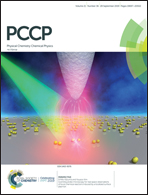Quantification of protein aggregation rates and quenching effects of amylin–inhibitor complexes†
Abstract
The formation of amyloid aggregates is the hallmark of many protein misfolding diseases, including Type-II diabetes mellitus, which is caused by the fibrillation of amylin protein. It is established that nano-sized ligands such as curcumin, resveratrol and graphene quantum dots can modify protein aggregation rates. In this article, we report a comparative study of these ligands to estimate their protein aggregation rates and fluorescence quenching using various experimental techniques. Through light scattering experiments, the RH of bare amylin was found to increase at a rate of 43% per day, whereas in the presence of the ligands in different molar ratios (A1C10, A1R10 and A1GQDs20), the sizes of the complexes were found to grow at rates of 7%, 8% and 13% per day, respectively. We observed fluorescence quenching using photoluminescence experiments for all three protein–ligand complexes. The protein aggregation rate and fluorescence quenching exhibited a concentration-dependent competitive role in the inhibition process. Interestingly, for graphene quantum dots, the protein aggregation rate is more affected at lower concentrations, while fluorescence quenching dominates at higher concentrations; this is in contrast to curcumin and resveratrol, where fluorescence quenching dominates at all concentrations of the ligands in the complex. The FTIR data showed appreciable conversion of β-sheets into less aggregation-prone secondary structures for all three amylin–ligand ratios; however, the inhibition performance of curcumin overshadowed those of the other two inhibitors. The inhibition behavior of these three ligands was corroborated by analysis of analytical and high-resolution TEM images of the fibrils.



 Please wait while we load your content...
Please wait while we load your content...